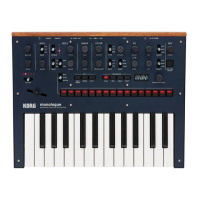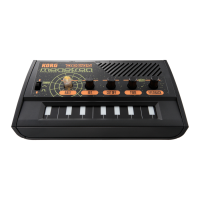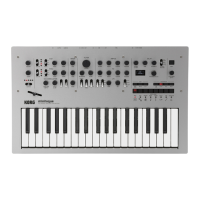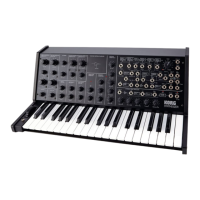Modulation
68
Kaoss Bttn CC 12
This is the front-panel KAOSS button (unipolar MIDI CC#12).
Damper CC 64
This is the damper or sustain pedal (unipolar MIDI CC#64).
Pitch Bend
This is the Pitch Bend wheel (MIDI Pitch Bend).
Velocity
This is the note-on velocity, representing how hard the note is played on the keyboard.
Exponential Velocity
This is MIDI note-on velocity through an exponential curve. Low velocities won’t have very much effect, and the
differences between lower velocities won’t be very noticeable. On the other hand, high velocities produce increasingly
greater effects, and the differences between higher velocities will be more pronounced.
Release Velocity
This is the note-off velocity, representing how quickly the note is released from the keyboard.
Gate and Gate+Damper
Gate is triggered by a new note after all notes have been released, such as at the beginning of a phrase. Gate+Damper is
similar, except that it is triggered by a new note-on after all notes and the damper are released.
Note-On Trig and NoteTrig+Damp
Note-On Trig is similar to Gate, but it triggers with every new note-on, even in the middle of a legato phrase.
NoteTrig+Damp includes the damper pedal in the equation, as shown in the diagram below.
Gate, Gate+Damper, Note-On Trig, and NoteTrig+Damp
Note Number
This provides simple key tracking, going from minimum at MIDI note 0 to maximum at MIDI note 127.
Aftertouch and Poly Aftertouch
These receive Aftertouch and Poly Aftertouch via MIDI.
Note: the modwave keyboard itself does not generate aftertouch.
Kaoss X
Kaoss X is the horizontal position of the Kaoss ball: negative to the left of center, 0 in the middle, and positive to the
right.
Kaoss Y
Kaoss Y is the vertical position of the Kaoss Ball: negative below the center, 0 in the middle, and positive above the
center.
Note-On Trig
NoteTrig+Damp
Gate
1
2
3
1
2
3
Gate+Damper
Damper Pedal
Note
On
Signal
Resets
Off
Time
